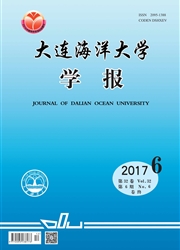

 中文摘要:
中文摘要:
进行了不同温度(10、14、17℃)和不同Cu(Ⅱ)质量浓度(7.40、32.63、56.58、193.94、300.48μg/L)的耦合作用对厚壳贻贝Mytilus coruscus D形幼虫生长和存活的急性毒性影响试验。结果表明:Cu(Ⅱ)胁迫96 h后,10、14℃试验组幼虫的存活率在Cu(Ⅱ)质量浓度为193.94、300.48μg/L时均显著降低(P〈0.05),17℃试验组幼虫的存活率在Cu(Ⅱ)质量浓度为56.58μg/L及以上时显著降低(P〈0.05);在温度为10、14、17℃时Cu(Ⅱ)胁迫的96 h半致死浓度(96 h LC50)分别为143.6、143.5、133.0μg/L,表明随着温度的升高LC50呈下降趋势;Cu(Ⅱ)胁迫96 h的生长试验结果显示,在10℃时,56.58μg/L质量浓度组的壳长相对增长率与对照组存在显著性差异(P〈0.05),14、17℃时,32.63、56.58μg/L质量浓度组的壳长相对增长率与对照组存在显著性差异(P〈0.05);在相同Cu(Ⅱ)浓度和不同水温胁迫下,17℃试验组幼虫壳长相对增长率显著高于10、14℃试验组(P〈0.05)。研究表明,Cu(Ⅱ)胁迫和温度的变化能影响厚壳贻贝D形幼虫的存活,且在较高的温度下幼虫对Cu(Ⅱ)胁迫更为敏感。
 英文摘要:
英文摘要:
In this study,the combined effects of temperature( from 10 ℃ to 17 ℃) and copper( Ⅱ) concentrations ranging from 0( control) to 300. 48 μg / L on survival and growth of straight-hinge veliger larvae were investigated in mussel Mytilus curuscus. The results showed that the larval survival in 10 and 14 ℃ groups was found to be significantly reduced at copper concentrations of 193. 94 and 300. 48 μg / L in 96 h( P〈0. 05),while the larval survival in 17 ℃ group was shown to be significantly reduced at copper concentrations ≥ 56. 58 μg / L in 96 h,with LC50 of 143. 6 μg / L at 10 ℃,143. 5 at 14 ℃ and 133. 0 μg / L 17 ℃,indicating that the LC50 values was decreased with warming temperature. The 96 h growth trial revealed that significant difference in the relative growth rates in shell length was only observed between the copper treated group( 56. 58 μg / L) and the control group at 10℃( P〈0. 05). At 14 ℃ and 17 ℃,however,significant difference in the relative growth rates in shell length was found between the the copper treated groups( 32. 63 and 56. 58 μg / L) and the control in 96 h( P〈0. 05). Within the same copper concentration and various temperature,there was significant higher shell growth rate at 17 ℃ than at 10 ℃ and 14 ℃ in 96 h. The findings indicate that copper stress and changes in water temperature affect survival of the straight-hinge veliger larvae,and that larvae are more sensitive to copper stress in higher temperature.
 同期刊论文项目
同期刊论文项目
 同项目期刊论文
同项目期刊论文
 Effects of neuroactive compounds, ions and organic solvents on larval metamorphosis of the mussel My
Effects of neuroactive compounds, ions and organic solvents on larval metamorphosis of the mussel My 期刊信息
期刊信息
